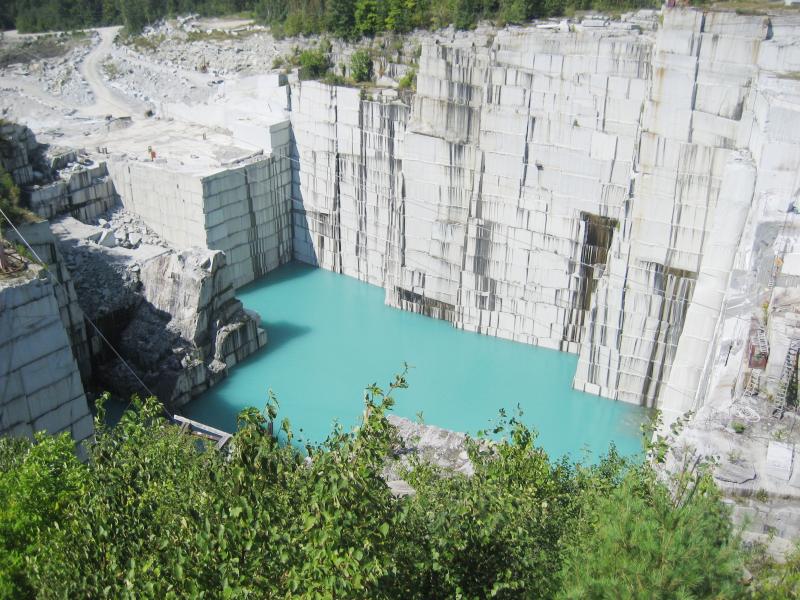10,000-year graves and other cemetery thoughts

Over the past few months, Sarah and I have been visiting cemeteries. Some to look for relatives, others to simply see what is the composition of the grounds. A few thoughts have come to our minds as we wander around. What's the most efficient way to search a cemetery for a specific name? Are there some patterns to discover when noticing the layout of the cemetery? What materials last the longest? What is the most legible over time? Could you get a 5,000-year grave which is still readable? 10,000-year? How much does grave care affect the longevity of a gravestone?
Longevity
America's oldest cemetery is in Duxbury, MA. It's about 360 years old. Many of the original Mayflower descendents are buried here. Most of the graves appear to be slate made from local stones. The New England weather hasn't helped these gravestones longevity. In most cases, they're exposed to the weather, versus being covered by trees, brush, or other flora to protect the stone. Of course, the flora itself can add to the wear and tear of the stone. One thing that caught my attention when reading up on the history of the cemetery is that Myles Standish was re-buried three times, where "he was finally placed into a copper box and sealed in a cement chamber." Why copper? Why cement? How has it aged since then?
Taking the opposite approach, let's ask how to build a 10,000 year monument. Of course, one comes across the 10,000 year clock project of the Long Now Foundation. It's a combination of stone and metal. It appears to be a mix of titanium, marine grade 316 stainless steel, stone, and ceramics. The Great Pyramids of Giza are about 4,600 years old. They composed of limestone, granite from Aswan, and mortar. Two things in common here are the environments. Both the clock and pyramids are constructed in dry climates in relatively geologically stable locations.
I vaguely remembered an old news story about how modern biodegradable plastics will take 400-500 years to degrade. A plastic gravestone won't last long enough to meet our 5,000-year minimum lifetime. Perhaps a ceramic one will, except probably prohibitively expensive and fragile if hit by debris in a storm.
After talking to a few stone masons and gravestone masons, it seems we're sticking with a high quality of granite, polished, and with some bronze extras. This will generally last 1,000 years; with proper care, longer. However, "with proper care" is highly unreliable. Something more or less impervious to the weather, debris, falling objects (like trees), and more major weather like hurricanes, earthquakes, and tornados probably suggests something not so tall, grand, and monumental. Something low, not so noticeable to grave robbers, vandals, and plundering hordes of the future.
Searching
I'm sure there are mathematical formulas and research into how to search a given unknown area with maximal efficiency. I didn't study them before searching for a given gravestone in an unknown cemetery. There is a certain structure and organization of cemeteries which once you figure it out, makes planning a search somewhat easier. The trick has been to maximize what you can see as you walk around the cemetery. The limit is really your own field of vision and readability of the gravestones as you walk around. Driving/riding/walking around the designated paths is one approach. It generally gives you a field of view into just the edges of plots and you can only see the most obvious names. Taking each section as a separate search area, lets you walk in an X pattern and see the vast majority of the head/grave stones. Of course, this has a lot of overlap as you get closer to the center of the X where your field of view overlaps. Picking a circle/oval somewhat in the midst between the center of the section and the edge you already covered can also work well. From practical experience, both patterns seem to take about the same time. The X pattern seems faster because you're able to walk faster and scan. The circle/oval pattern seems longer because you have to scan more as you end up looking around trying to cover everything.
Mortality
All of this searching, researching, thinking, and all is secondary to the fact that you're surrounded by the dead. Some trees last 5,000 years, some single-celled organisms last minutes. It can be sobering at times, but also endlessly fascinating to research and see what you can learn about the lives of the people around you. In the end, everything dies, it's the best reason you have to live.
Photo Credit: Rock of Ages quarry by rosethornil.